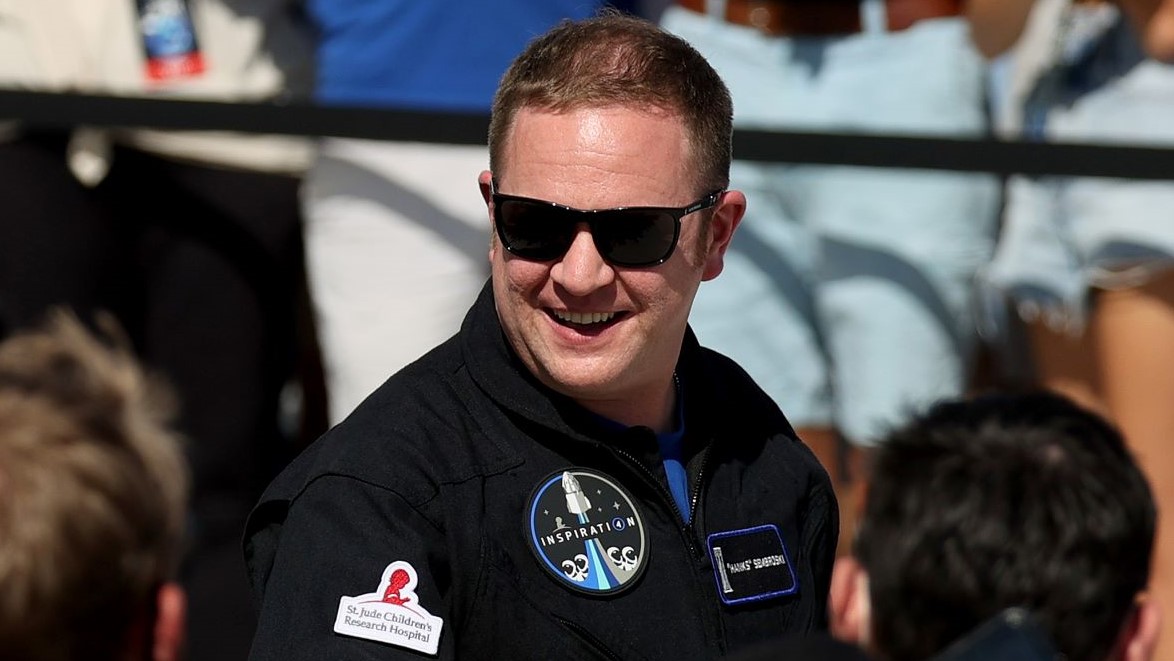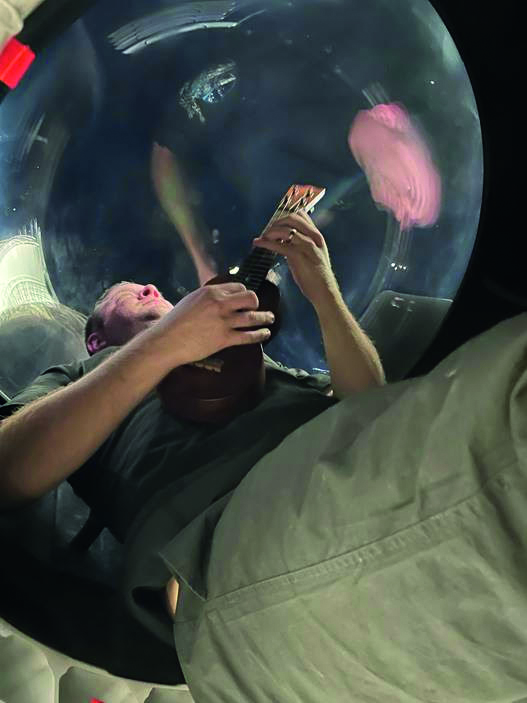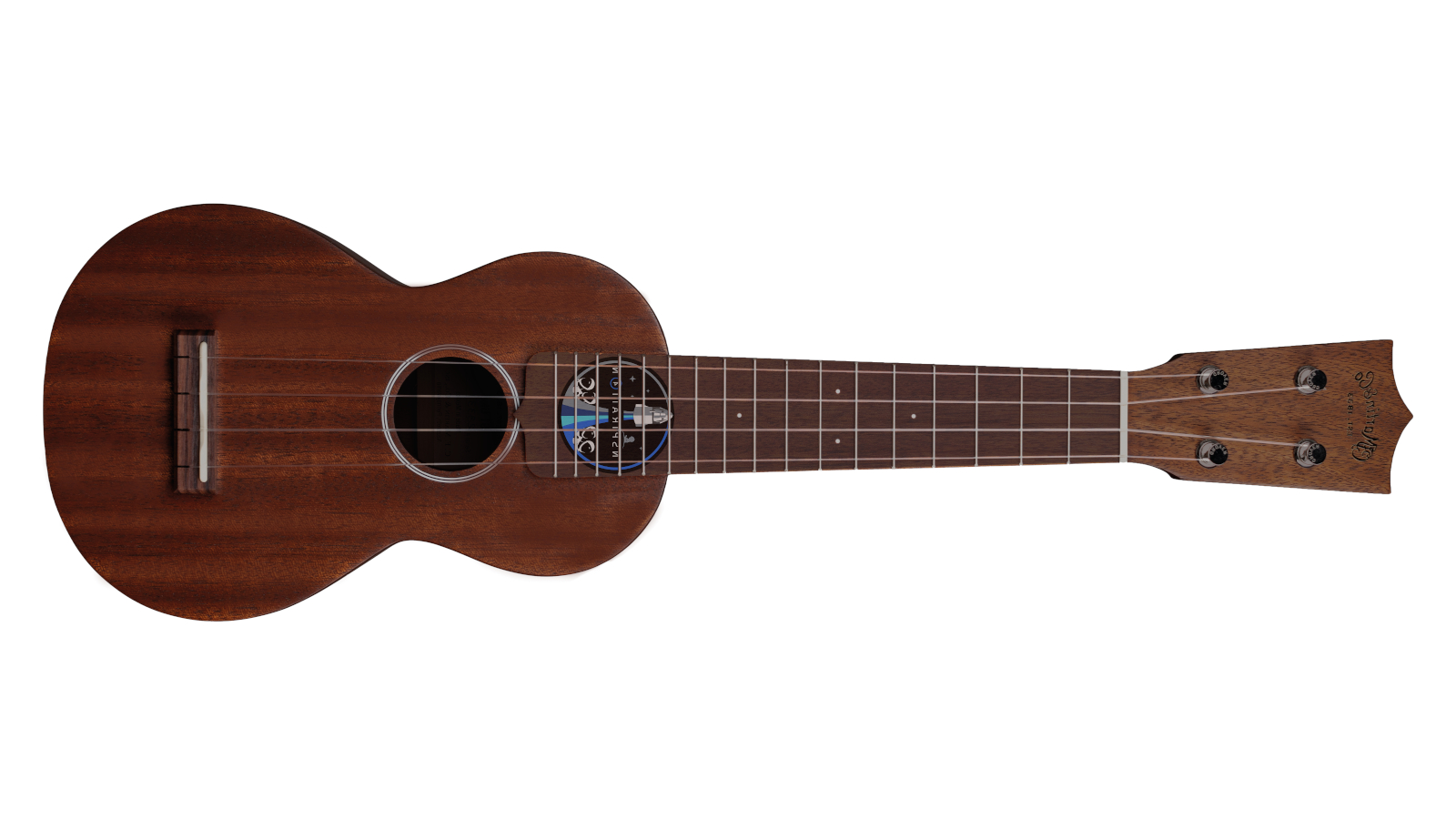If You Strum a Ukulele In Space, Does It Make a Sound? Find Out In This Incredible Interview With Astronaut Chris Sembroski
The Air Force veteran took a Martin ukulele to space and discovered the joy of making music in microgravity.

If you strum a ukulele in space, does it make a sound? In Chris Sembroski’s case, it certainly makes a difference. The Air Force veteran won the Generosity seat on the first-ever all civilian crew for SpaceX’s Inspiration4 mission. With a donation to St. Jude’s Children’s Research Hospital, the U.S. Space Camp counselor and Lockheed Martin data engineer was entered in the contest that ultimately punched his ticket beyond the stratosphere.
He brought a Martin soprano ukulele designed specially for the mission aboard and played it in space. That uke, autographed by the entire crew, was auctioned off last year during St. Jude’s Virtual Holiday Auction as a part of the overriding goal of raising $200 million.
The other members of Inpiration4 included commander and benefactor Jared Isaacman representing Leadership, Dr. Sian Proctor representing Prosperity and Hayley Arcenaux representing Hope. Arcenaux is a cancer survivor who was treated at St. Jude’s and now works there.
The Netflix documentary Countdown: Inspiration4 Mission to Space, introduced the crew to the world prior to the September 15 launch, which SpaceX streamed live. Watching the Dragon capsule engulfed in flames as it burst forth made the extraordinary danger level extremely obvious. After orbiting the earth over three days at the highest altitude ever – beyond the International Space Station – the crew splashed down safely in the Atlantic.
It was truly inspirational to watch civilians train and transform into superheroes. It's in that spirit that we approached Sembroski. He’s a musical hobbyist rather than the kind of acoustic guitar fabuloso normally featured, but he certainly has a fabulous story to tell about a mind-blowing musical experience playing in space.
Martin Guitar has long been a champion of exploration and continues to push the envelope of guitar sustainability (see this review of the 00L Earth). The historic manufacturer created a commemorative ukulele made from sustainably sourced sinker mahogany in a soprano size similar to the model “Ukulele” Dick Konter brought along on Admiral Richard Byrd’s 1926 pioneer mission to the North Pole. Inspiration4 has clear parallels to that historic trek, and represents another giant step for civilian musical adventurers like "Ukulele Dick" and Chris “Hanks” Sembroski.

What was the impetus for making some music on this mission?
All the latest guitar news, interviews, lessons, reviews, deals and more, direct to your inbox!
This mission represents the democratization of space, and so it resonates with me that as we try to bring more humans into space, we want to bring more of our humanity with us. As a member of the first all-civilian crew, I thought it would be a good idea to bring some music into space. I figured I could make that contribution. My entire family is musical, but I’m the only one that has really picked up the guitar, and then this summer the ukulele, as my favorite form of musical expression and outlet for creativity.
Can you cite a favorite player or two?
I love listening to Dave Matthews, and John Mayer is a heck of a guitar player. I’m blown away by the way his mind works and how it follows a different pattern, compared to how music gets taught in school. These guitar players are not strictly confined to, say, the four beats of a measure, one measure at a time. They’ve got this whole circle of rhythm and melody that comes together.
I think it was Dave Matthews’ drummer [Carter Beauford] who said that to play a rhythmic pattern with all its syncopation until it comes back around, you have to think like you’re playing on a circle: Find the moments where those different highlights and beats land. Imagine that circle goes on for 16 or 32 counts, or however long it’s extended, and as you come around full circle, then you know exactly where you’re landing each time you arrive at home.
It’s like you’re playing in a shower with great acoustics.
Chris Sembroski
Kind of like an orbit?
Right. And then there’s the nature of acoustics. My parents were always involved with our church music program, and because of that background I pay attention to the acoustics at a concert. I listen for those resonant frequencies booming throughout the show.
There are neat acoustics happening when you’re flying in space around Earth in a Dragon capsule. The fans create a constant white noise, which is okay, because it covers a lot of sins. The acoustics of the cabin are unique, because all the walls are hard but nothing is symmetrical about the way the sound bounces off of them. It’s like you’re playing in a shower with great acoustics.

And it’s not a cube or a rectangular shower either, so the sound doesn’t come back in an overpowering way. Those hard-sided walls give the sound back to your ears in very present way. You feel right there with the music as it’s bouncing around and filling the capsule. But then the sound dissipates just as quickly. You don’t get that long, sustaining reverb there. You feel free, and it sounds good to just sort of belt it out a bit, because then you’re not drowned out by the fans. It’s actually a very fun place to play.
How did you wind up bringing along a Martin ukulele?
Martin is located close to where the ships were headquartered in Pennsylvania. A guitar would have been too big, so I agreed to try a ukulele. They sent me a wonderful tenor-sized ukulele that I fell in love with and sent down to SpaceX, but it turned out to be a couple of inches too big to fit in the box. I was devastated. Martin flipped into overdrive. They were able to produce a soprano ukulele and turn it in to SpaceX within about a week and a half. It felt tiny in my hands compared to the way my fingers were used to landing on the frets. I resolved to think tiny and skinny in order to get my fingers to push down on those strings in a way that worked.

> The soprano is the smallest-sized ukulele Martin makes and the same size as the Konter Uke that made the trip to the North Pole in 1926.
> The whole body is made from sinker mahogany, an environmentally friendly wood taken from logs that were submerged in the rivers of Belize more than 200 years ago. The result is a bass-rich sound, with more volume than normal mahogany.
> The bridge and fingerboard are made of FSC certified rosewood.
> The mission patch inlay is made of black gloss acrylic; white G10 (fiberglass); light-gray G10; dark-gray reconstituted stone black mop; dark-blue recon stone dark lapis; teal recon stone chrysocolla; blue Corian.
It’s an incredible historic parallel that another Martin soprano ukulele traveled along the surface of the Earth to the North Pole.
Chris Sembroski
What did you think of its tone?
I was pleasantly surprised, and it was louder than I expected. That Martin ukulele has an incredible resonance that really does fill the space. And having been newly manufactured, it had that new wood smell. I couldn’t get enough of it. It’s an incredible historic parallel that another Martin soprano ukulele traveled along the surface of the Earth to the North Pole, and that this one covered about 60 percent of the Earth’s surface flying 580 kilometers above it. I was playing music, going over everybody’s houses at 17,000 miles per hour!
What were the primary player moments?
There were two. The first time was during a show-and-tell session. I had just finished breakfast and found out we were going live shortly. While the camera was on Hayley and Sian showing off the cupola – the big domed window above – I dove underneath the seats to pull out the ukulele. I was thinking about something representative I could play in a few moments, so I put a few G, F, and C chords together to make it sound like a song.
The other moment was one I wanted to do for the crew, and I’d been thinking about it the whole time. After watching President Biden's inauguration celebration, I kept thinking about the Black Pumas and how their song “Colors” fit perfectly with what we were going to be seeing in space. Looking down from that altitude, all of the colors you see are those back here on Earth. And I was going to be up there with people that have become, like the song says, “my sisters and my brothers.” Listening to that song and hearing those higher guitar notes, I thought it would come across on a ukulele pretty well.
I kept thinking about the Black Pumas and how their song “Colors” fit perfectly with what we were going to be seeing in space.
Chris Sembroski
Martin helped me out. They sent [indie pop singer-songwriter] A.J. Smith to give me a couple of lessons. He helped me rearrange where my fingers were on the fretboard so that it would come across better. It was rough to get those fingerings down, especially on the soprano. I was anxious about having personally committed myself to try singing a song that’s probably too high for my voice, but the crew was very receptive. They all loved that song to begin with, and it became our theme song for the mission. They were very kind to me when I ended up actually playing the song and getting into it. It was one of those moments where, if you can just let go and not think about what you’re doing, take a few deep breaths and play, the music just kind of comes up and you connect better with people.

So you feel that you pulled it off?
I messed it up so bad. [laughs] I got so nervous. That was literally the scariest part of this whole mission for me. Jared caught a little video, maybe the beginning of a verse through to the chorus. We will have to see if that gets out in public. At the very beginning of the Netflix documentary there is a couple of bars of me picking out the “Colors” intro that you might recognize if you look for it.
What’s it like physically to play while floating around in microgravity?
You’ve got to hold that little soprano in a different way, using your right forearm to kind of lean the body up against your stomach to keep it anchored. You’ve also got to hold loosely with your left hand so that you don’t get too stuck in one position where you can’t transition between different chord structures. I ended up going into the cupola to play more of the technical stuff that I was trying to do with “Colors.” There were some places where I could get my feet anchored below me and have room to take a few deep breaths. I would essentially go up into this bubble and turn it into my little gym and music recording area.
It would be different outside, with no air for the strings to vibrate against. The only sense of sound you would hear would be through anything that is touching the ukulele.
Chris Sembroski
Did the lack of a strong gravitational pull affect string vibrations?
I didn’t notice a whole lot of that. Granted, it would be different outside, with no air for the strings to vibrate against. The only sense of sound you would hear would be through anything that is touching the ukulele, such as your hand, your chest, back up through your own body to your eardrums. That would be the only path for sound to come through. Isn’t that a big part of what music is anyway? You feel it in your chest, depending on how it resonates.
And what about the duration of string vibrations in outer space?
There’s still tension, so it would continue to move back and forth. It might take longer to slow down or…
Endless sustain?
Yeah, my assumption is that it would simply keep going in the absence of air causing friction to slow it down. The energy has to be dissipated somewhere for the string or the musical instrument to slow down its vibrations. It would just continue.
Having had such an otherworldly experience, can you draw a larger musical correlation between what’s happening in space to what’s happening on Earth?
We’re all connected in the solar system as we’re going around the sun, and the planets have this continuous rhythmic cycle to how they orbit the sun. That’s what music is too. It’s this continuous, repetitive pattern of different intonations that bring the colors of a song or a whole piece of music together. Without that happening in the solar system, we wouldn’t have everything on Earth that makes it such a special place to live.
The earthly correlation to what you just accomplished might be a casual guitarist getting a chance to play Carnegie Hall. What can you relay from your training and experience to aspiring players?
No matter what you’re doing, be willing to stay humble and not afraid to say “yes” when it comes to taking on challenges or risks, putting yourself out there and exposing your weaknesses. You only get better. At the end of the day, it’s still just you doing what you love, no matter what a critic says. And if someone lets you take the opportunity to express yourself in any way, know that you’re going to be surrounded by people that are putting themselves through the exact same thing, and they'll help you out. They’ll be supportive no matter what. I found that to be the case with my crew.
Jimmy Leslie is the former editor of Gig magazine and has more than 20 years of experience writing stories and coordinating GP Presents events for Guitar Player including the past decade acting as Frets acoustic editor. He’s worked with myriad guitar greats spanning generations and styles including Carlos Santana, Jack White, Samantha Fish, Leo Kottke, Tommy Emmanuel, Kaki King and Julian Lage. Jimmy has a side hustle serving as soundtrack sensei at the cruising lifestyle publication Latitudes and Attitudes. See Leslie’s many Guitar Player- and Frets-related videos on his YouTube channel, dig his Allman Brothers tribute at allmondbrothers.com, and check out his acoustic/electric modern classic rock artistry at at spirithustler.com. Visit the hub of his many adventures at jimmyleslie.com
